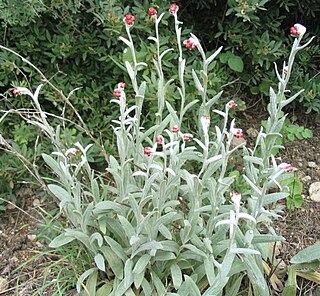
The genus Helichrysum consists of an estimated 600 species of flowering plants in the sunflower family (Asteraceae). The type species is Helichrysum orientale. They often go by the names everlasting, immortelle, and strawflower. The name is derived from the Anicent Greek words ἥλιος and χρῡσός.

Dicentra, known as bleeding-hearts, is a genus of eight species of herbaceous plants with oddly shaped flowers and finely divided leaves, native to eastern Asia and North America.

Syncarpha is a genus of herbaceous flowering plants in the family Asteraceae. The flowers are known by the common name: everlastings. The genus is endemic to the fynbos of the Eastern and Western Cape in South Africa.

The black-chested mountain tanager is a species of bird in the family Thraupidae.
The Canthyloscelidae are a small family of midges closely related to the Scatopsidae.
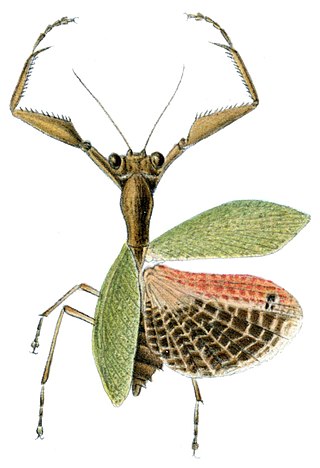
Acontista is a genus of mantises in the family Acanthopidae.

Staehelina is a genus of flowering plants in the tribe Cardueae within the family Asteraceae.
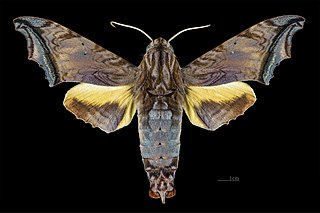
Nyceryx is a genus of moths in the family Sphingidae. The genus was erected by Jean Baptiste Boisduval in 1875.

Enypniastes is a genus of deep-sea sea cucumber. It is monotypic, being represented by the single species Enypniastes eximia. Due to its unique appearance, the species has been dubbed the headless chicken fish, headless chicken monster, and the Spanish dancer. It is also known as the swimming sea cucumber, and some are called the pink see-through fantasia.
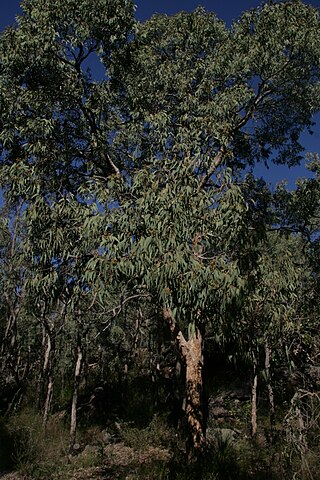
Corymbia eximia, commonly known as yellow bloodwood, is a bloodwood native to New South Wales. It occurs around the Sydney Basin often in high rainfall areas on shallow sandstone soils on plateaux or escarpments, in fire prone areas. Growing as a gnarled tree to 20 m (66 ft), it is recognisable by its distinctive yellow-brown tessellated bark. The greyish green leaves are thick and veiny, and lanceolate spear- or sickle-shaped. The cream flowerheads grow in panicles in groups of seven and appear in spring. Known for many years as Eucalyptus eximia, the yellow bloodwood was transferred into the new genus Corymbia in 1995 when it was erected by Ken Hill and Lawrie Johnson. It is still seen under the earlier name in some works.

Dicentra peregrina is a herbaceous perennial growing from a rhizome, native to mountains in Japan and nearby areas of East Asia.
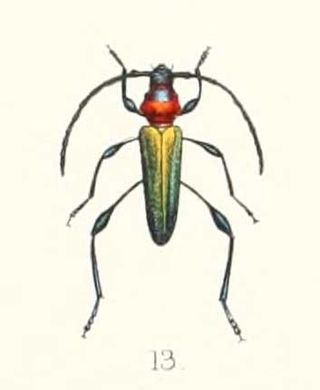
Eximia is a genus of round-necked longhorn beetles of the subfamily Cerambycinae.
Emarginella is a genus of small keyhole limpets, marine gastropod molluscs in the family Fissurellidae.
Coloconger eximia is an eel in the family Colocongridae. It was described by Peter Henry John Castle in 1967, originally under the genus Ascomana. It is a marine, deep-water dwelling eel which is known from Cape Peninsula, South Africa, in the southeastern Atlantic Ocean.

Morchella eximia is a globally-occurring fungus in the family Morchellaceae (Ascomycota), first described by Émile Boudier in 1910. In an elaborate phylogenetic and nomenclatural revision of the genus in 2014, Richard and colleagues showed that the taxa Morchella anthracophila, Morchella carbonaria, and Morchella septimelata, proposed in 2012 by Clowez and Kuo et al. respectively, are all later synonyms of this old taxon.

Aprophata eximia is a species of beetle in the family Cerambycidae. It was described by Newman in 1842, originally under the genus Abryna. It is known from the Philippines.

Anodonthyla eximia is a species of frog from Ranomafana in Eastern Madagascar endemic microhylid subfamily Cophylinae. It is the smallest species of the genus Anodonthyla and is the only known terrestrial member of the genus.
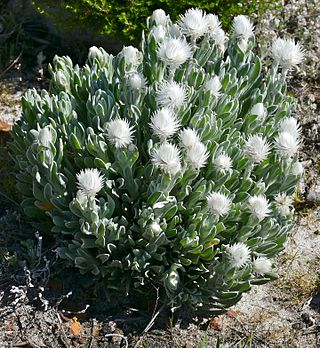
Syncarpha vestita is a species of flowering plant. It belongs to the genus Syncarpha, and family Asteraceae. It is endemic to the Cape Provinces of South Africa.
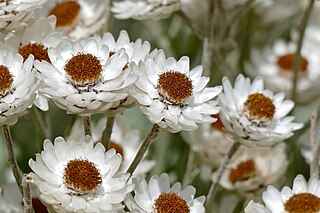
Syncarpha argyropsis is a species of flowering plant found on the south coast of South Africa. It was first described as Helipterum argyropsis by DC. in 1838, and given the current name by Rune Bertil Nordenstam in 1989. Syncarpha argyropsis belongs to the genus Syncarpha and family Asteraceae.
















